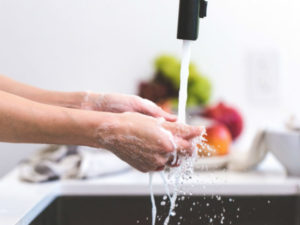HAND WASHING OR SANITIZER? THE LATEST RESEARCH REVEALS BEST USE PRACTICES
As posted to the Canadian Jewish News:
By: Dr. Deborah Mechanic
November 1, 2019
‘Tis the season. Cold and flu season, that is!
It’s that time of year where handshakes turn into quick fist bumps, and tissue boxes in public places start to increase exponentially. The season when one friend gets sick, and

then a relative, and the an acquaintance, and we hear the term “there’s something going around”.
It’s instinct that we go into protective mode, cleaning our hands, not touching our face, and monitoring the high germ places and activities that might require extra cleansing. The choices are limited but simple when it comes to damage control: washing or sanitizing.
There’s been a complimentary relationship between hand washing with soap, or with sanitizer in the past, and the general rules are: something is better than nothing; do what you can and use what’s available and convenient. Hand sanitizer has provided a good solution when hand washing isn’t available, in prevention of the spread of germs.
Interestingly, there is a difference between washing versus sanitizing, and the most current research displays that they are not equals at combatting the war on germs. In the past, it was hypothesized that hand washing is better than sanitizing for a number of reasons, including the balance of good and bad bacteria (yes, your hands have good bacteria too!), and the moisture in your skin. Yet it wasn’t until recently that the concept has been backed by evidence.
Hand washing usually takes between one and two minutes of time, and when using germicidal or disinfectant soaps, there is little debate over its effectiveness. In fact, proper methods to hand washing are considered so effective, that steps, timing and reminders are posted everywhere from hospital bathrooms, to restaurant kitchens, to make sure it’s done right.
Sanitizer, for a long time, has been a stand-in for hand washing when the time isn’t available. In fact, it’s become so convenient that there are stations set up in hospitals for visitors, and keychain-size bottles for kids to take to school. Previous studies, conducted on dried mucus, indicate that 30 seconds of sanitizing (before it dries), can kill up to 99 per cent of bacteria. But the latest studies would indicate there’s more to the story. New research shows that sanitizer actually takes four minutes before drying to kill germs at the level it claims, when used with wet mucus or greasy and dirty hands.
Mucus, as annoying as it can be when we’re sick, is not inherently bad. Our body produces mucus as an immune response to trap viruses and bacteria from entering our tissues. We expel it in bulk as a way to get the germs out of our body. It’s designed to be difficult to penetrate. Think of mucus as armour, getting bacteria out of our body before it has a chance to escape and do harm. This is why it takes some time for alcohol to break it down and kill microbes within it. The CDC states that “Alcohol-based hand sanitizers can quickly reduce the number of microbes on hands in some situations, but sanitizers do not eliminate all types of germs.”
Unfortunately, in the real world we deal with wet mucus and greasy hands as well as dry hands, making the latest results a difficult truth – that sanitizing might just not be enough. The research does not dispute the ability of sanitizer to kill germs once it’s broken through mucus or grease, which indicates that sanitizer does still add value to our routine.
Based on current guidelines, the CDC indicates that any sanitizer used should have minimum 60 per cent alcohol, and it’s still a good option in hospitals and doctors offices where hands are dry and not greasy. Sanitizer will kill microbes and germs in 30 seconds and is still a good choice. However, in situations where one may have dirty, greasy, or soiled hands, soap and water are better. In general, hand washing is the recommended and preferred method for keeping your hands clean. For more information on effective hand washing and other tips to avoid bugs this season, talk to your doctor or visit the CDC webpage: https://www.cdc.gov/handwashing/index.html
